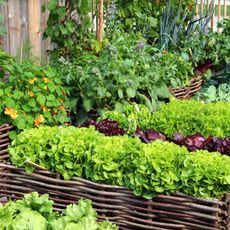Fertilization Of Garlic: Tips On Feeding Garlic Plants


Garlic is a long-season crop, and takes about 180-210 days to maturation, depending upon the variety. So as you may imagine, the proper fertilization of garlic is of paramount importance. The question is not only how to fertilize garlic, but when is the best time for feeding garlic plants?
Garlic Plant Fertilizer
Garlic is a heavy feeder, basically because it takes so long to come to fruition. Because of this, it's best to think about feeding garlic plants right from the start. In most climates, garlic bulbs should be planted in late fall or early winter -- six weeks before the soil freezes.
In milder areas, you may plant garlic in January or even February for late summer or early fall. Prior to either of these planting times, you should amend the soil with plenty of compost, which will become the basis for fertilizing your garlic as well as aid in water retention and drainage.
You can also use manure or 1-2 pounds (0.5-1 kg) of all-purpose fertilizer (10-10-10), or 2 pounds (1 kg.) of blood meal per 100 square feet (9.5 sq. m.) of garden space. Once the garlic has been sown, it is time to consider a schedule for further fertilization of garlic.
How to Fertilize Garlic
Fertilization of garlic plants should occur in the spring if you planted in the fall. Fertilizing your garlic can occur either by side dressing or broadcasting fertilizer over the entire bed.
The best garlic plant fertilizer will be high in nitrogen, those containing blood meal or a synthetic source of nitrogen. To side-dress, work the fertilizer in an inch (2.5 cm.) down or so and about 3-4 inches (7.5-10 cm.) from the plant.
Fertilize every three to four weeks. Fertilize your garlic again just before the bulbs swell, around mid-May. By all accounts, however, do not fertilize with high nitrogen foods after May, as this may stunt the bulb size. Keep the area around your garlic weed-free since it doesn't compete well with weeds. Water the garlic deeply every eight to 10 days if spring is dry but taper off in June.
Gardening tips, videos, info and more delivered right to your inbox!
Sign up for the Gardening Know How newsletter today and receive a free download of our most popular eBook "How to Grow Delicious Tomatoes."
Start checking for mature cloves at the end of June. It's best to dig one out and cut it in half to check for maturity since the green tops of garlic don't die back like other Alliums when they are ready. You're looking for plump cloves covered with thick, dry papery skin.
Cure bulbs in a shaded, warm, dry, and airy place for a week. Garlic can be stored for months in a cool, dry, dark area. Cold temperatures promote sprouting, so do not store in the refrigerator.
Love Gardening Know How? Our latest book, The Complete Guide to Vegetable Gardening, is available now!
Perfect for the gardener in your life, or for your own coffee table, this book boasts 224 pages of high-quality pictures, expert tips, and easy-to-follow advice to get your vegetable garden growing its best. Look for it at these sellers, and wherever quality books are sold.

Amy Grant has been gardening for 30 years and writing for 15. A professional chef and caterer, Amy's area of expertise is culinary gardening.
-
 "My Worst Mistake" – Gardeners Share 10 Hard-Learned Lessons
"My Worst Mistake" – Gardeners Share 10 Hard-Learned LessonsGardeners never stop learning, and sometimes our mistakes are the best teachers. But why not save time and heartache by learning from other gardeners' failures?
By Melanie Griffiths
-
 Crops for Urban Growing: 8 Edible Plants For Urban Gardens
Crops for Urban Growing: 8 Edible Plants For Urban GardensUrban edible gardening lets your yard do double duty of beauty and practicality. Have fun combining edible plants with ornamentals.
By Teo Spengler
